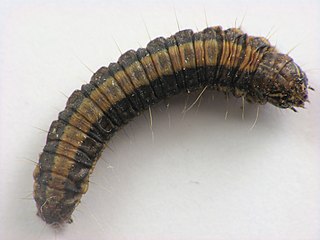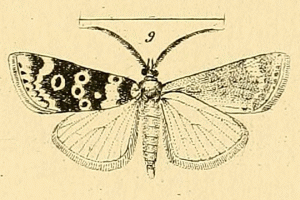
Spilomelinae is a very species-rich subfamily of the lepidopteran family Crambidae, the crambid snout moths. With 4,135 described species in 344 genera worldwide, it is the most speciose group among pyraloids.

Luthrodes is a genus of butterflies in the family Lycaenidae erected by Hamilton Herbert Druce in 1895. Its species are found in Asia and in Oceania.

Cirrhochrista is a genus of moths of the family Crambidae described by Julius Lederer in 1863.

Herpetogramma is a genus of moths in the family Crambidae described by Julius Lederer in 1863. It currently comprises 106 species that are found in North America, Eurasia, Australia, New Zealand, Central and South America. Of the few species where host plants are known, the larvae mostly feed on grasses.

Hyalobathra is a genus of moths of the family Crambidae. The genus was erected by Edward Meyrick in 1885.
Hydropionea is a genus of moths of the family Crambidae. The 13 described species are distributed in Central and South America.

Microthyris is a genus of pyraloid moths, belonging to the subfamily Spilomelinae of the grass moth family (Crambidae). The genus was first described by Julius Lederer in 1863.

Synclera is a genus of moths of the family Crambidae described by Julius Lederer in 1863.

Terastia is a genus of snout moths in the subfamily Spilomelinae of the family Crambidae. It was described by Achille Guenée in 1854 with Terastia meticulosalis as type species. The genus is currently placed in the tribe Margaroniini, where it is closely related to the genera Agathodes and Liopasia.

Conistra is a genus of moths of the family Noctuidae. The genus was erected by Jacob Hübner in 1821. There are three subgenera, Orrhodiella, Dasycampa and Peperina.
Celonoptera is a monotypic moth genus in the family Geometridae. Its only species, Celonoptera mirificaria, is found in south-eastern Europe. Both the genus and species were first described by Julius Lederer in 1862.

Bepea is a moth genus in the subfamily Spilomelinae of the family Crambidae.

The Epipaschiinae are a subfamily of snout moths. More than 720 species are known today, which are found mainly in the tropics and subtropics. Some occur in temperate regions, but the subfamily is apparently completely absent from Europe, at least as native species. A few Epipaschiinae are crop pests that may occasionally become economically significant.

Aglossa ocellalis is a species of snout moth in the genus Aglossa. It was described by Julius Lederer in 1863 and is known from Uganda and the Democratic Republic of the Congo. There is one record of an accidental introduction from Scotland.

Jocara is a genus of snout moths. It was described by Francis Walker in 1863.
Hypsopygia resectalis is a species of snout moth in the genus Hypsopygia. It was described by Julius Lederer in 1863 and is known from Venezuela.

Tallula is a genus of pyralid moths in the family Pyralidae. There are about 11 described species in Tallula.

Lineodini is a tribe of the species-rich subfamily Spilomelinae in the snout moth family Crambidae.

Agroterini is a tribe of the species-rich subfamily Spilomelinae in the pyraloid moth family Crambidae. The tribe was erected by Alexandre Noël Charles Acloque in 1897.

Margaroniini is a tribe of the species-rich subfamily Spilomelinae in the pyraloid moth family Crambidae. The tribe was erected by Charles Swinhoe and Everard Charles Cotes in 1889, originally as family Margaronidae.
















